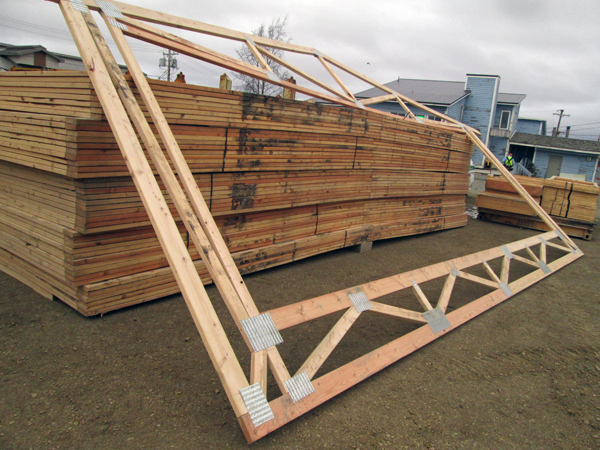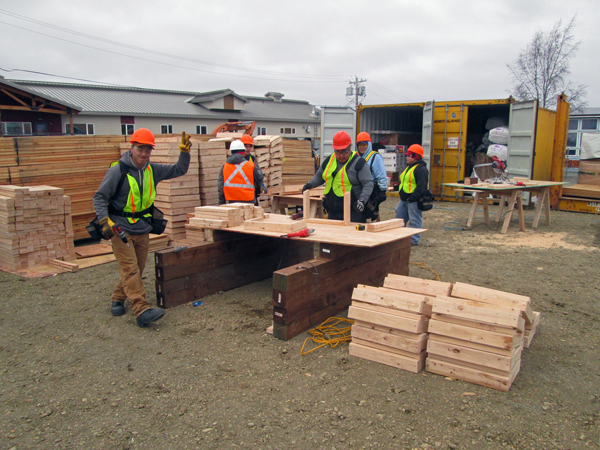
The State of Alaska has awarded a grant to the Yukon Kuskokwim Economic Development Council, YKEDC, for a truss-manufacturing project.
If the plan goes forward, local workers would use the region’s wood resources to build frames for highly energy efficient housing.
If all goes as planned, there will be a truss manufacturing plant in Bethel supplied by logging operations and saw mills in upriver villages, within the next few years.
Brent Latham is the Economic and Energy Development Director at theAssociation of Village Council Presidents, AVCP, the regional tribal non-profit that houses the new YKEDC, for which he’s also director. He says the project has the potential to create new jobs in one of the state’s most economically depressed regions.
“It would be dozens of jobs, in my thinking, especially with the truss-manufacturing plant combined with the additional jobs that would be needed to harvest timber and make lumber out of timber,” said Latham.
The grant of about $70,000 was awarded January 23rd. Half of it was awarded immediately and the other half will be dispersed after a mid-year report is submitted. The funds are intended to support the truss-manufacturing project from assessment and feasibility to implementation.

AVCP President Myron Naneng says local manufacturing could have cost advantages for building housing.
“[We’re] trying to find ways to reduce cost of ordering material from out of state sources, and also have some of the supplies in Bethel that can be shipped to the local area villages,” said Naneng.
The goal is to promote regional economic development and improve housing. 40 percent of housing stock in the region is considered over crowded and about 3,000 homes should be replaced according to a feasibility study produced for AVCP by the Cold Climate Housing Research Center and funded by the state of Alaska. Jack Hebert is CEO for the non-profit that works to develop energy efficient building technology adapted for the arctic. He says the plant would supply trusses made from local white spruce for a their ‘integrated truss’ design. Hebert says the design isn’t fancy but it’s adaptable and much more energy efficient than the houses that exist in the region now.
“Our typical home that’s built with this technique, a house that would use, a regular framed house, about 1200 gallons a year in fuel, uses more like 200 hundred gallons a year in fuel. It’s about an 80 percent reduction,” said Hebert.
Hebert says the Cold Climate Housing Research Center has tested the design throughout the state and has two duplexes that use it under construction in Bethel now. Eventually they’ll serve as dormitories for AVCP flight and aircraft maintenance schools.
Nolan Klouda, withUniversity of Alaska Anchorage’s Center for Economic Development is developing business plans for the project.
“Our role in the project is to help with the business analysis and the business planning. So we’re going to be doing some financial modeling and projections on the two business operations really, the sawmill and the truss plant,” said Klouda.
Klouda says the business planning should be done by the end of June. AVCP and YKEDC officials say they still have to secure construction funding and probably won’t break ground on the truss plant until 2016.
Daysha Eaton is a contributor with the Alaska Public Radio Network.
Daysha Eaton holds a B.A. from Evergreen State College, and a M.A. from the University of Southern California. Daysha got her start in radio at Seattle public radio stations, KPLU and KUOW. Before coming to KBBI, she was the News Director at KYUK in Bethel. She has also worked as the Southcentral Reporter for KSKA in Anchorage.
Daysha's work has appeared on NPR's "Morning Edition" and "All Things Considered", PRI's "The World" and "National Native News". She's happy to take assignments, and to get news tips, which are best sent via email.
Daysha became a journalist because she believes in the power of storytelling. Stories connect us and they help us make sense of our world. They shed light on injustice and they comfort us in troubled times. She got into public broadcasting because it seems to fulfill the intention of the 4th Estate and to most effectively apply the freedom of the press granted to us through the Constitution. She feels that public radio has a special way of moving people emotionally through sound, taking them to remote places, introducing them to people they would not otherwise meet and compelling them to think about issues they might ordinarily overlook.




